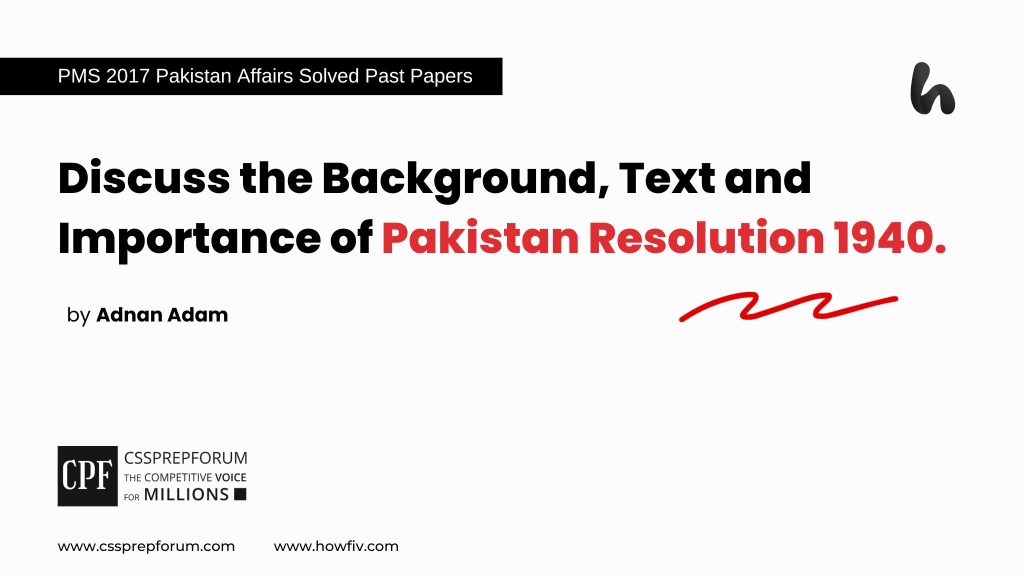PMS 2017 Solved Pakistan Affairs Past Papers | Discuss the Background, Text and Importance of Pakistan Resolution 1940.
The following question of PMS Pakistan Affairs 2017 is solved by Adnan Adam under the supervision of Miss Nirmal Hasni on the guided pattern of Sir Syed Kazim Ali, which he taught to his students, scoring the highest marks in compulsory subjects for years. This solved past paper question is uploaded to help aspirants understand how to crack a topic or question, how to write relevantly, what coherence is, and how to include and connect ideas, opinions, and suggestions to score the maximum.

Outline
1-Introduction
2- Influencing factors behind the Pakistan Resolution
- ✓Failure of the All-India Muslim League (AIML) in 1937 Elections
- ✓Muslims at the mercy of Congress Rule
- ✓AIML Lucknow Session in October 1937
- ✓World War II and the Day of Deliverance
- ✓Allahabad Address by Allama Iqbal
3- Comprehending Pakistan Resolution
- ✓The Pakistan Resolution, adopted by the All India Muslim League (AIML), was the first political demand for the Muslims of the subcontinent.
- ✓The Pakistan resolution demonstrated a clutch moment in the making of a separate homeland.
4- Significance of Pakistan Resolution
- ✓Legitimizing of demand for a separate Muslim land
- ✓Empowering distinct cultural values and political identity of Muslims
- ✓Shifting in political dynamics
- ✓Working as a catalyst for the creation of Pakistan
5- Critical Analysis
6- Conclusion

Answer to the Question
Introduction
The Pakistan Resolution, a renowned historical event, played a pivotal role in the creation of Pakistan, a separate nation for Muslims in the Indian subcontinent. The failure of the All-India Muslim League (AIML) in the 1937 elections shattered the hopes of Muslims of the subcontinent. Soon, they realized the need to separate Muslim land owing to the despotic policies imposed by Congress. Hence, Muslims believed that Islam was in danger, and their suffering under Congress rule was further exacerbated. In this background, the All-India Muslim League held its Session on 23 March 1940, in which the famous Lahore Resolution, also known as the Pakistan Resolution, was presented by the premier of Bengal, Abul Kassam Fazul Haq. Nevertheless, the Resolution held significance in the making of Pakistan because the Resolution itself demanded a separate Muslim land on the basis of Islamic ideology. Moreover, the Resolution was a complete statement of Muslims’ demands for the protection of their religion, culture, politics, and other rights and interests. Analytically, the Resolution articulated the political aspirations of the Muslim League and served as a cornerstone in shaping the future of the region. In short, the never-ending self-determination and yearning for freedom jolted the Muslims towards the establishment of Pakistan.
“The Muslims and Hindus belong to two different civilizations which are based mainly on conflicting ideas and conceptions.”
Quaid-e-Azam

Influencing Factors Behind Pakistan Resolution:
(a) Failure of AIML in the 1937 elections
The unexpected results of the 1937 elections had gathered the Muslims to unite on a single platform. Owing to the setbacks suffered during the Khilafat Movement and the improper selection of candidates from rural areas, as stated by Sir Khawaja Nazimuddin, were the main reasons for the defeat in the 1937 elections. As a result, Congress formed the government in 7 out of 11 provinces in India.
(b) Muslims at The mercy of Congress Rule
The Congress not only alienated the Muslims through their conduct but also imposed certain unethical practices on Muslims, such as the singing Vande Mataram, preaching anti-muslim novel Anand Math, and saluting Gandhi’s portrait. Such despotic behaviour of Congress jolted the inner soul of Muslims to gain their lost glory and prestige. In accordance with the given circumstances, the Muslim League published three reports about Congress hegemony: the Pirpur Report, the Sharif Report, and the Fazlul Haq Report.
(c) AIML Lucknow Session in October 1937
The Session was organized by the Raja of Mahmudabad. Therefore, a large number of Muslim premiers attended the Session and manifested their united interests in prevailing the Muslim league. Thus, they wanted the Muslim league to represent them at the centre. Consequently, in October 1937, the Lucknow session was proved to be resurgent for Muslims. As Quaid-e-Azam said at the Session,
“The Congress has shown their hand that Hindustan is for the Hindus.”
(d) World War II and the Day of Deliverance
After the break-out of World War II in September 1939, the Congress refused to join the British unless the British accepted Independence for India. Consequently, the congress ministers resigned due to the refusal of Independence from the British. Thus, Jinnah found it a sole chance to consolidate their political gains. Therefore, the Muslims rejoiced in the deliverance from the Congress rule in December 1939.
(e) Allahabad Address by Allama Iqbal
Allama Iqbal became the first politician who expressed the true notion of the Two Nation Theory, narrating the basic principles of Islam and the loyalties of the Muslims to their faith. In this regard, he demanded a separate homeland and political Independence for the Muslims of India. In his address, Iqbal said
“I would like to see the Punjab, North-West Frontier Province, Sindh and Baluchistan amalgamated into a single State. Self-government within the British Empire, or without the British Empire, the formation of a consolidated North-West Indian Muslim State appears to me to be the final destiny of the Muslims, at least of North-West India.”
Comprehending Pakistan Resolution
The Pakistan Resolution was the first political declaration endorsed by the All-India Muslim League (AIML) to have a separate Muslim nation. Notably, the miserable conditions of Muslims at the hands of Congress had convinced them to demand a separate homeland. Owing to the events that occurred between 1937 and 1940, the All-India Muslim League held its Session in Lahore on 23 March 1940. The Resolution states,
“No Constitution plan would be workable or acceptable to Muslims, unless it is designed on the basic principle, namely, the geographical contiguous units, where Muslims are in the majority as in the North Western and Eastern zones of India should be grouped to constitute ‘independent states’ in which the constituent units shall be autonomous and sovereign .”
The Resolution further emphasized framing such a constitution that includes all basic principles, such as defence, external affairs, and customs and traditions. Likewise, Quaid-e-Azam further gave a clear expression of a separate homeland. As he said,
“Musalmans have always been taken for granted as a minority. The Musalmans are a nation by any definition.”
Significance of Pakistan Resolution
(a) Legitimacy of demand for a Separate Muslim Land
For the first time in the history of the sub-continent, the Muslims united on a firm stance and demanded a separate Muslim homeland in front of the British. Thus, the Pakistan Resolution proved to be the legitimate demand for the creation of Pakistan. However, the word “Pakistan’ was not used initially by the All-India Muslim League, and it was the Hindu Newspaper which ultimately used the word “Pakistan.
(b) Distinct cultural Values and Political identity of Muslims
The Pakistan Resolution affirmed Muslims as a separate political entity with their own religious, cultural, and social values. Moreover, the Resolution emphasized the concept of the ‘Two Nation Theory’. As Jinnah said,
“The Hindus and Muslims belong to two different religions, philosophies, social customs and literature.”
(c) Shift in political dynamics
The Resolution proclaimed Muslims a distinct political entity with their own interests and aspirations. It not only fostered a sense of unity among Muslims but also negotiated with the British government on a political basis. Moreover, it highlighted the need to protect Muslim interests in diverse India.
(d) Catalyst for the Creation of Pakistan
The Resolution served as a groundwork for the creation of Pakistan. However, the untiring efforts of Muslim leaders gained momentum over the years and played a crucial role in negotiations leading to the partition of India. Illustratively, the Resolution symbolized the commitment to the principle of self-determination and sovereignty.
“Pakistan not only means freedom and independence but the Muslim Ideology which has to be preserved, which has come to us a precious gift, and we hope others will share with us.”
Muhammad Ali Jinnah
Critical Analysis
Critically, the Resolution lacked a clear idea regarding territorial boundaries and the structure of the proposed Muslim state, leading to later disputes during partition. Moreover, in the initial stages, the Muslim political leaders manifested different ideological perspectives. However, the Resolution holds its due importance in the history of Pakistan.
Conclusion
To sum up, the Pakistan Resolution was a defining moment in the creation of Pakistan that reshaped the political landscape of the undivided India. Moreover, the Resolution not only left a lasting impact on the cultural, social, and political identity of the region but also strengthened the Muslims to unite on a unique idea of a separate homeland. At last, the struggle for Pakistan after the Resolution had become more evident.

CSS Solved Past Papers’ Essays
Looking for the last ten years of CSS and PMS Solved Essays and want to know how Sir Kazim’s students write and score the highest marks in the essays’ papers? Then, click on the CSS Solved Essays to start reading them.
CSS Solved Essays
CSS Solved General Science & Ability Past Papers
Want to read the last ten years’ General Science & Ability Solved Past Papers to learn how to attempt them and to score high? Let’s click on the link below to read them all freely. All past papers have been solved by Miss Iqra Ali & Dr Nishat Baloch, Pakistan’s top CSS GSA coach having the highest score of their students. General Science & Ability Solved Past Papers
Articles Might Interest You!
The following are some of the most important articles for CSS and PMS aspirants. Click on any to start reading.












